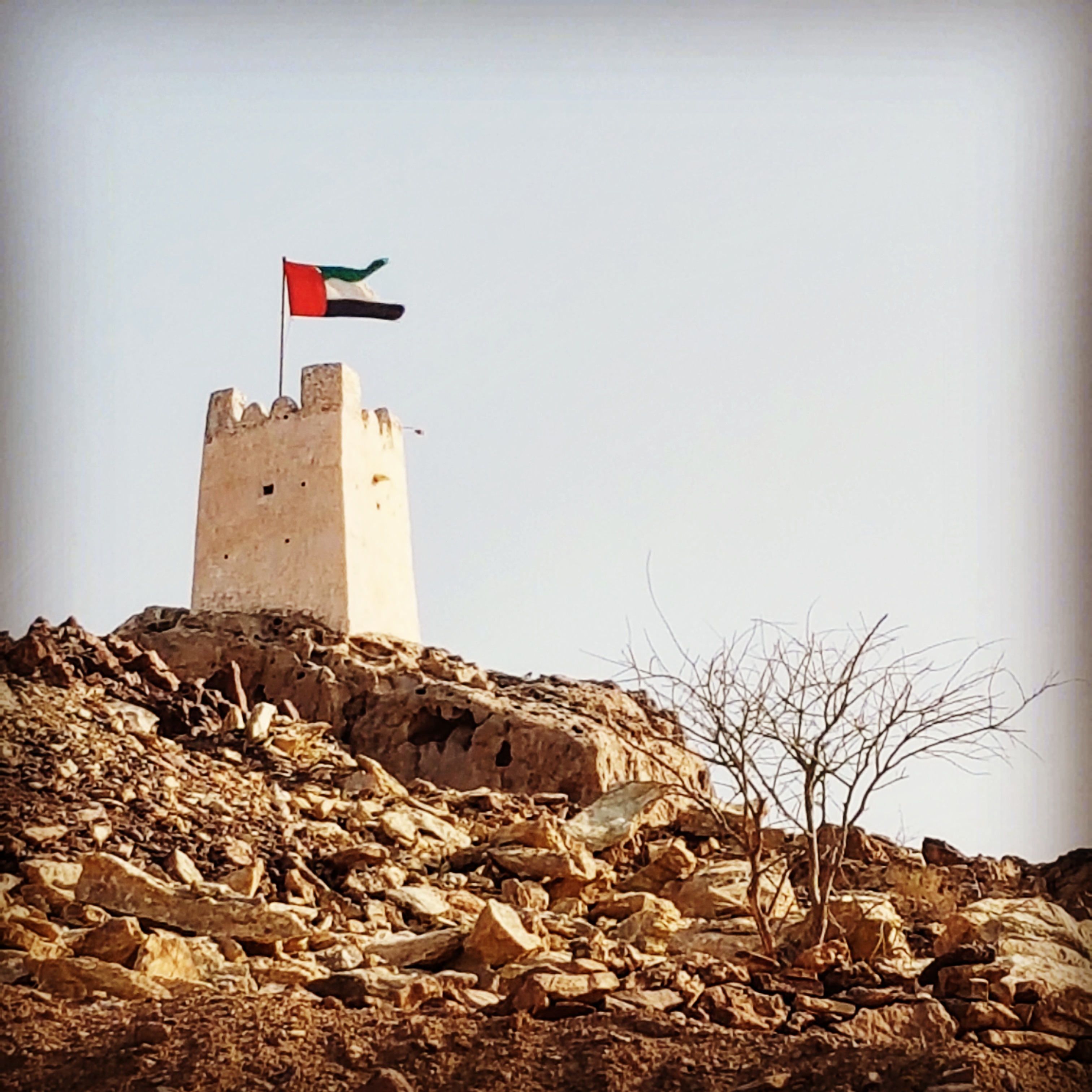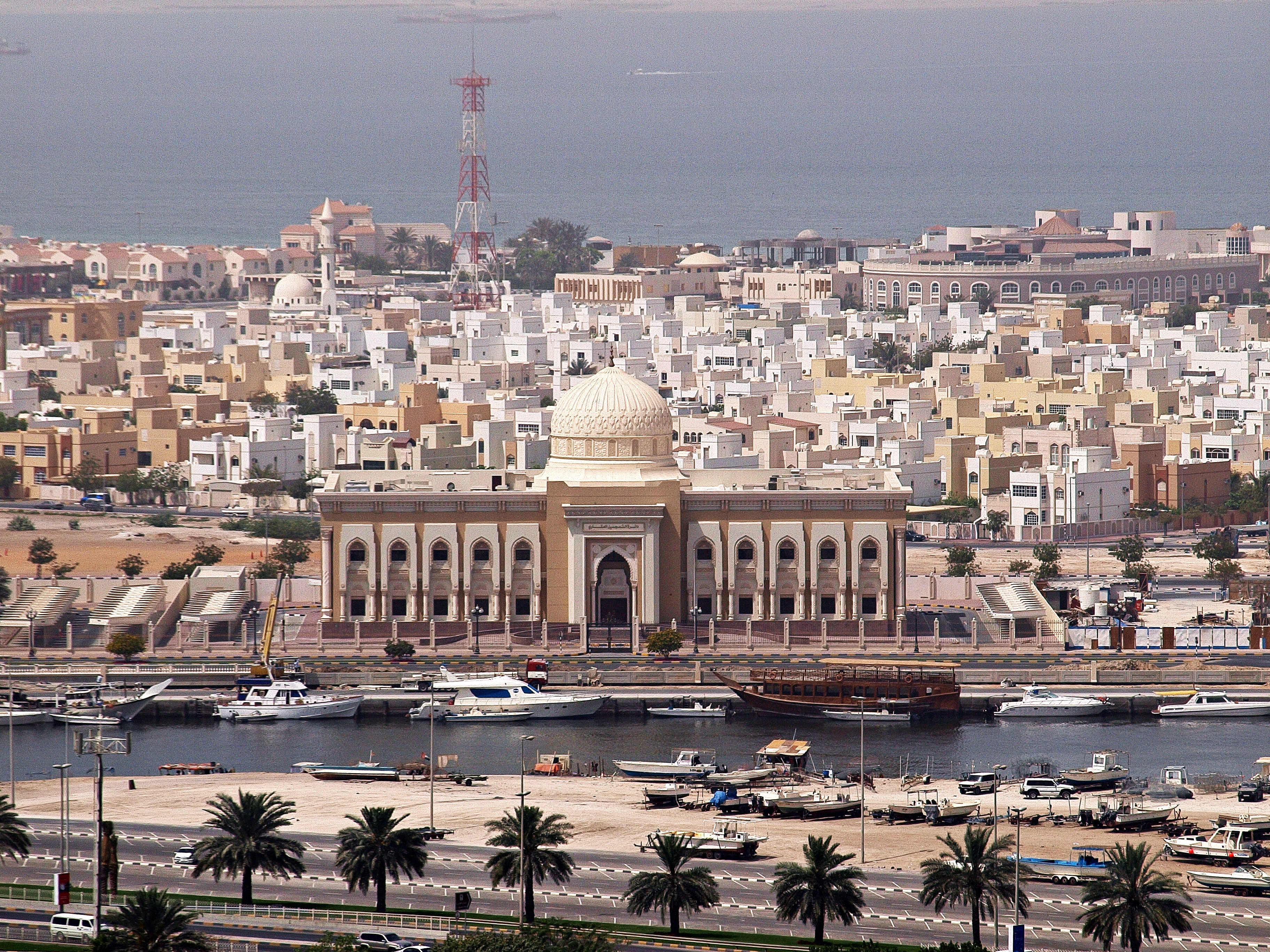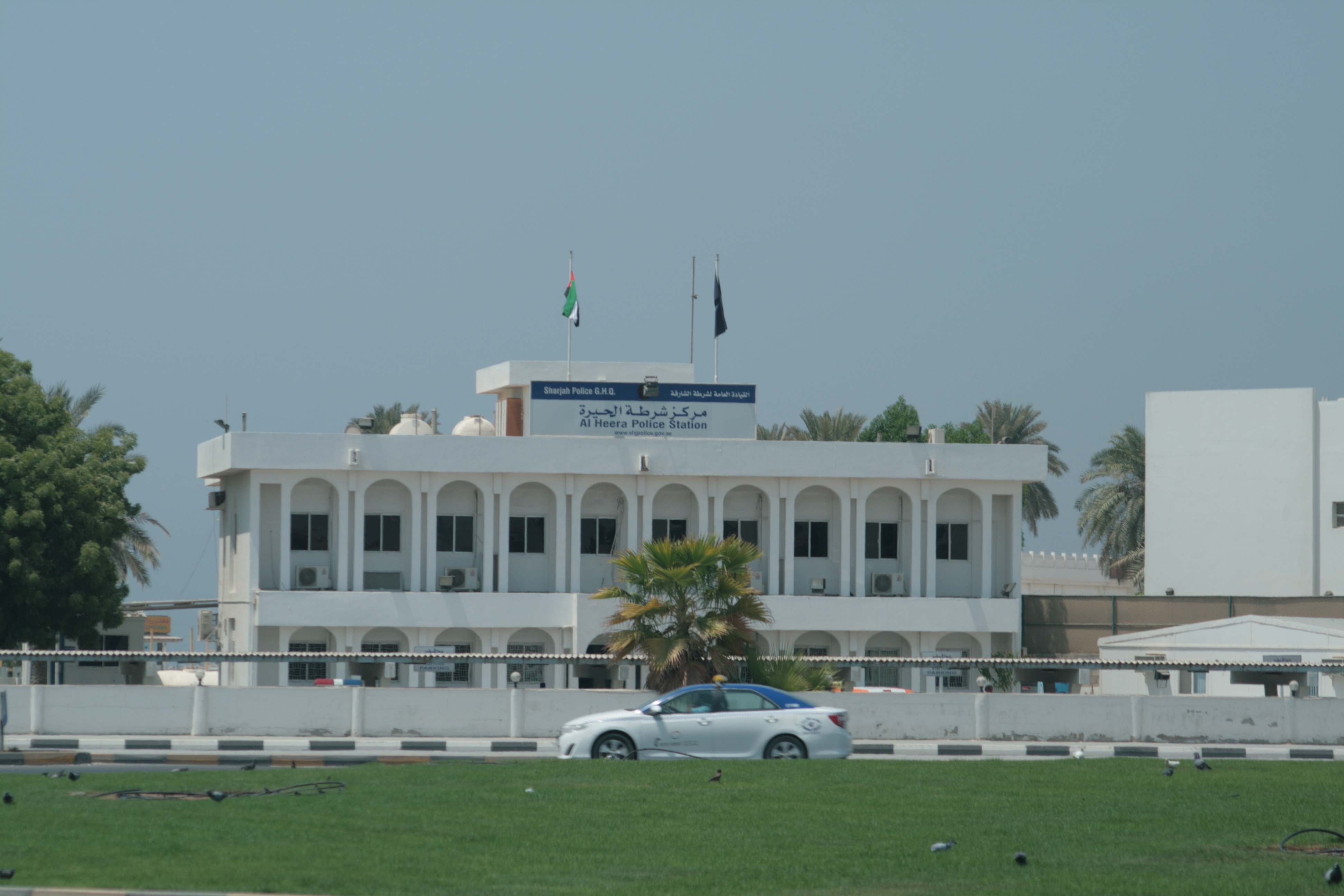|
Al Bu Shamis
The Al Bu Shamis () or Al Shawamis () (singular Al Shamsi ) is an Arab Bedouin tribe that mostly inhabit the southeastern part of the Arabian peninsula. They are located mainly in Northern Oman, the United Arab Emirates, and to a lesser extent Kuwait, Qatar, eastern Saudi Arabia, Bahrain and Iraq. Due to the large nature of the tribe, there are today in fact many branches that trace themselves to the Al Bu Shamis tribe. Origins The Na'im is divided into three sections, the Al Bu Kharaiban, the Khawatir, and the Al Bu Shamis. It is from the former section that the current Rulers of the emirate of Ajman are drawn. Of the three sections, the Al Bu Shamis has become virtually independent and associated closely with the Al Bu Falasa of Dubai. Migration The Al bu Shamis emigrated from Western Arabia to settle around the Sunaynah area (an inland desert settlement in the Buraimi Wilayat of Oman ). Later migrations led some of them to Al Ain and Buraimi oases. Al Shamsi were also tr ... [...More Info...] [...Related Items...] OR: [Wikipedia] [Google] [Baidu] |
Bedouin Tribe
The Bedouin, Beduin, or Bedu (; , singular ) are nomadic Arab tribes who have historically inhabited the desert regions in the Arabian Peninsula, North Africa, the Levant, and Mesopotamia. The Bedouin originated in the Syrian Desert and Arabian Desert but spread across the rest of the Arab world in West Asia and North Africa after the spread of Islam. The English word ''bedouin'' comes from the Arabic ''badawī'', which means "desert dweller", and is traditionally contrasted with ''ḥāḍir'', the term for sedentary people. Bedouin territory stretches from the vast deserts of North Africa to the rocky sands of the Middle East. They are traditionally divided into tribes, or clans (known in Arabic as ''ʿašāʾir''; or ''qabāʾil'' ), and historically share a common culture of herding camels and goats. The vast majority of Bedouins adhere to Islam, although there are some fewer numbers of Christian Bedouins present in the Fertile Crescent. Bedouins have been referred t ... [...More Info...] [...Related Items...] OR: [Wikipedia] [Google] [Baidu] |
Al Buraimi Governorate
Al Buraimi Governorate ( ar, مُحَافَظَة ٱلْبُرَيْمِي, Muḥāfaẓat Al-Buraimī) is one of the 11 governorates of Oman which was split from the Ad Dhahirah Region. Until October 2006, the area was part of Ad Dhahirah Region. At this time, the new governorate was created from the Wilayats (Provinces) of Al Buraymi and Mahdah. A third wilayat, As- Sunaynah, was created from parts of the two. The town of Al-Buraimi is an oasis town in northwestern Oman, on the border of the United Arab Emirates. An adjacent city on the UAE's side of the border is Al Ain. Both settlements are part of the historical region of Tawam or Al-Buraimi Oasis. For many decades, there had been an open border between Al-Buraimi located in Oman and Al-Ain. Effective from 16 September 2006, this border has been relocated to an area around Hilli which is around from the traditional open border. The traditional border near Al-Ain City is now closed to all except to those with valid visas ... [...More Info...] [...Related Items...] OR: [Wikipedia] [Google] [Baidu] |
Tribes Of Saudi Arabia
The term tribe is used in many different contexts to refer to a category of human social group. The predominant worldwide usage of the term in English is in the discipline of anthropology. This definition is contested, in part due to conflicting theoretical understandings of social and kinship structures, and also reflecting the problematic application of this concept to extremely diverse human societies. The concept is often contrasted by anthropologists with other social and kinship groups, being hierarchically larger than a lineage or clan, but smaller than a chiefdom, nation or state. These terms are equally disputed. In some cases tribes have legal recognition and some degree of political autonomy from national or federal government, but this legalistic usage of the term may conflict with anthropological definitions. In the United States, Native American tribes are legally considered to have "domestic dependent nation" status within the territorial United States, with ... [...More Info...] [...Related Items...] OR: [Wikipedia] [Google] [Baidu] |
Tribes Of The United Arab Emirates
The term tribe is used in many different contexts to refer to a category of human social group. The predominant worldwide usage of the term in English is in the discipline of anthropology. This definition is contested, in part due to conflicting theoretical understandings of social and kinship structures, and also reflecting the problematic application of this concept to extremely diverse human societies. The concept is often contrasted by anthropologists with other social and kinship groups, being hierarchically larger than a lineage or clan, but smaller than a chiefdom, nation or state. These terms are equally disputed. In some cases tribes have legal recognition and some degree of political autonomy from national or federal government, but this legalistic usage of the term may conflict with anthropological definitions. In the United States, Native American tribes are legally considered to have "domestic dependent nation" status within the territorial United States, with ... [...More Info...] [...Related Items...] OR: [Wikipedia] [Google] [Baidu] |
Ali Mohammed Balmur Al Shamsi
ʿAlī ibn Abī Ṭālib ( ar, عَلِيّ بْن أَبِي طَالِب; 600 – 661 CE) was the last of four Rightly Guided Caliphs to rule Islam (r. 656 – 661) immediately after the death of Muhammad, and he was the first Shia Imam. The issue of his succession caused a major rift between Muslims and divided them into Shia and Sunni groups. Ali was assassinated in the Grand Mosque of Kufa in 661 by the forces of Mu'awiya, who went on to found the Umayyad Caliphate. The Imam Ali Shrine and the city of Najaf were built around Ali's tomb and it is visited yearly by millions of devotees. Ali was a cousin and son-in-law of Muhammad, raised by him from the age of 5, and accepted his claim of divine revelation by age 11, being among the first to do so. Ali played a pivotal role in the early years of Islam while Muhammad was in Mecca and under severe persecution. After Muhammad's relocation to Medina in 622, Ali married his daughter Fatima and, among others, fathered Ha ... [...More Info...] [...Related Items...] OR: [Wikipedia] [Google] [Baidu] |
Al Nuaim
The Na'im () (singular Al Nuaimi ) is an Arab tribe in the United Arab Emirates. The tribe is also present in other gulf countries. The Na'im is divided into three sections, the Al Bu Kharaiban, the Khawatir and the Al Bu Shamis (singular Al Shamsi). It is from the former section that the current Rulers of the Emirate of Ajman are drawn. Of the three sections, the Al Bu Shamis has become virtually independent and associated closely with the Al Bu Falasa of Dubai. The traditional heart of Na'im territory was the oasis town of Buraimi and nearby Al Ain, where Na'im expansion came at the expense of the Dhawahir tribe, but also rubbed up against the Bani Yas and the allied Manasir. Although the Na'im were linked to the growing Wahhabi influence in the Buraimi area and adopted the doctrine, they allied with other forces to evict the Wahhabis from Buraimi and subsequently occupied many of the forts around Buraimi. Origins In 1818, according to the 'British Assistant Political Agent ... [...More Info...] [...Related Items...] OR: [Wikipedia] [Google] [Baidu] |
Abdulaziz Nasser Al Shamsi
Abdulaziz Nasser Al Shamsi ( ar, عبدالعزيز ناصر الشامسي) is the director of protocol at the ministry of foreign affairs in the United Arab Emirates. Al Shamsi who was born in Ajman in 1956 obtained his bachelor's degree in business administration at the University of Cairo in 1980. He is married to Hissa Abdulla Ahmed Al-Otaiba. Dec 27, 2008 Diplomatic career * Ambassador Extraordinary and Plenipotentiary to Italy (From: March 2008 – Present) * Director of Protocol (From: August 2007 to March 2008) * Permanent Representative of the UAE to the United Nations (From: September 2001 to July 2007). * Director, Department of International Organizations & Conferences, Ministry of Foreign Affairs (From: August 2001 to 20/05/2002). * Ambassador Extraordinary an ...[...More Info...] [...Related Items...] OR: [Wikipedia] [Google] [Baidu] |
Taryam Omran Taryam
Taryam Omran Taryam (1942–2002) was the co-founder of Dar Al Khaleej Printing & Publishing, a publishing house based in Sharjah, United Arab Emirates. Together with his brother, Abdullah Omran Taryam, he founded the first UAE daily national newspaper '' Al Khaleej'', as well as the English-language daily ''Gulf Today''. Early life Born in Sharjah in 1942 and educated in Sharjah and Kuwait, Taryam Omran Taryam completed his education with a degree from Egypt. In 1970, Taryam co-founded Dar Al Khaleej together with his brother Abdullah, and launched a weekly magazine, ''Al Shurouq''. This was followed on 19 October 1970 with the launch of ''Al Khaleej'', the first newspaper in what was then the Trucial State of Sharjah. An active participant in the process leading to the establishment of the United Arab Emirates on 2 December 1971, he was subsequently appointed as the new nation's first Ambassador to Egypt and also the first UAE Permanent Ambassador to the Arab League. He was ... [...More Info...] [...Related Items...] OR: [Wikipedia] [Google] [Baidu] |
Saeed Mohammed Al Shamsi
Dr. Saeed Mohammed Al-Shamsi is a lawyer, diplomat, and a former assistant foreign minister for international organizations affairs with the rank of an ambassador. Ambassador Dr. Al Shamsi was UAE's former ambassador to Australia. He's married and has three children. Academic Qualifications *Ph.D in International Relations - College of International Services, American University, Washington. *M.A. in International Public Policy - Johns Hopkins University, Baltimore, Maryland. *Bachelor in Political Science - Arizona State University, Arizona. Diplomatic career Dr. Al Shamsi started his diplomatic career in 1974 and held the following positions: *25/10/1981 - UAE Embassy in Washington, United States. *26/6/1988 - 12/3/1992 Ambassador to the Federal Republic of Germany. *31/1/1989 – 12/3/1992 Non Resident Ambassador to the Kingdom of Norway. *10/2/1989 – 12/3/1992 Non Resident Ambassador to the Republic of Finland. *16/3/1989 – 12/3/1992 Non Resident Ambassador to the ... [...More Info...] [...Related Items...] OR: [Wikipedia] [Google] [Baidu] |
Emirate Of Sharjah
The Emirate of Sharjah (; ar, إِمَارَة ٱلشَّارِقَة ') is one of the emirates of the United Arab Emirates, which covers and has a population of over 1,400,000 (2015). It comprises the capital city of Sharjah, after which it is named, and other minor towns and exclaves such as Kalba', Al Dhaid, Dibba Al-Hisn and Khor Fakkan. The emirate is an absolute monarchy. It has been ruled by Sultan bin Muhammad Al-Qasimi since 1972, except for a six-day period during an attempted coup d'etat by his brother, Sheikh Abdulaziz bin Mohammed Al-Qasimi. History Human settlement in the area covered by the emirate has existed for over 120,000 years, with significant finds made of early axes and stone tools as well as Copper and Iron Age implements in Al Dhaid, Al Thuqeibah, Mileiha, Tell Abraq, Muwailah, Al Madam and Jebel Faya. Archaeological finds in the Mleiha area point to human habitation consistent with the spread of humanity from Africa to the wider world, evidenced ... [...More Info...] [...Related Items...] OR: [Wikipedia] [Google] [Baidu] |
Al Heera
Al Heera is a suburb in Northern Sharjah (emirate), Sharjah in the United Arab Emirates, traditionally home to the Darawishah, part of the Al Bu Shamis section of the Na'im tribe. At one stage declaring its independence from Sharjah, with its own Sheikh, it formally became part of the Emirate of Sharjah in 1942 on the death of its Ruler, Abdulrahman Al Shamsi. A coastal settlement with a small harbour formerly used by a number of fishermen and pleasure boat owners, its main distinguishing feature today is its police station, converted in 2019 into the 'Al Heera Literature Society' building. The original coastal fishing village, built mainly of traditional Emirati adobe and coral houses, sat along the corniche in the area immediately behind the Al Heera Police Station but fell into disuse and was home to taxi drivers and illegal labourers through the 1990s until it was cleared. Little remains today to mark where the original settlement existed. History Al Heera is first mentioned ... [...More Info...] [...Related Items...] OR: [Wikipedia] [Google] [Baidu] |
Al Hamriyah
Al Hamriyah is the name of a coastal settlement of Sharjah on the northern perimeter of the United Arab Emirates. It is one of nine municipalities of the emirate, and is wedged between the emirates of Ajman (south) and Umm Al Qawain (north). It is notable for its lagoon popular with pleasure boaters and jet skiers as well as local fishermen who moor here, as well as storing and repairing both rope and wire mesh fishing nets. The village is not to be confused with the Hamriyah Port and Free Zone, which lie immediately to the south of it. It is traditionally home to families belonging to the Darawishah section of the Al Bu Shamis Na'im, linked through this relationship to the area of Sharjah bounding immediately to the south of Ajman, Al Heera. These would be associated with the modern Emirati family name ''Alshamsi''. History Going un-noted in early 19th-century British coastal surveys, Al Hamriyah struggled for independence in the late 19th century as a result of alleged negl ... [...More Info...] [...Related Items...] OR: [Wikipedia] [Google] [Baidu] |







